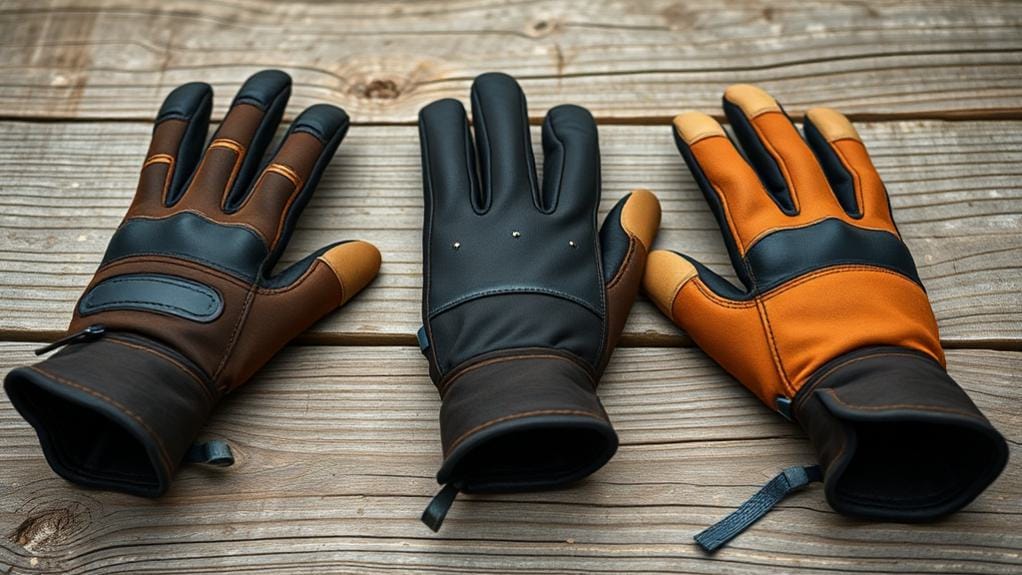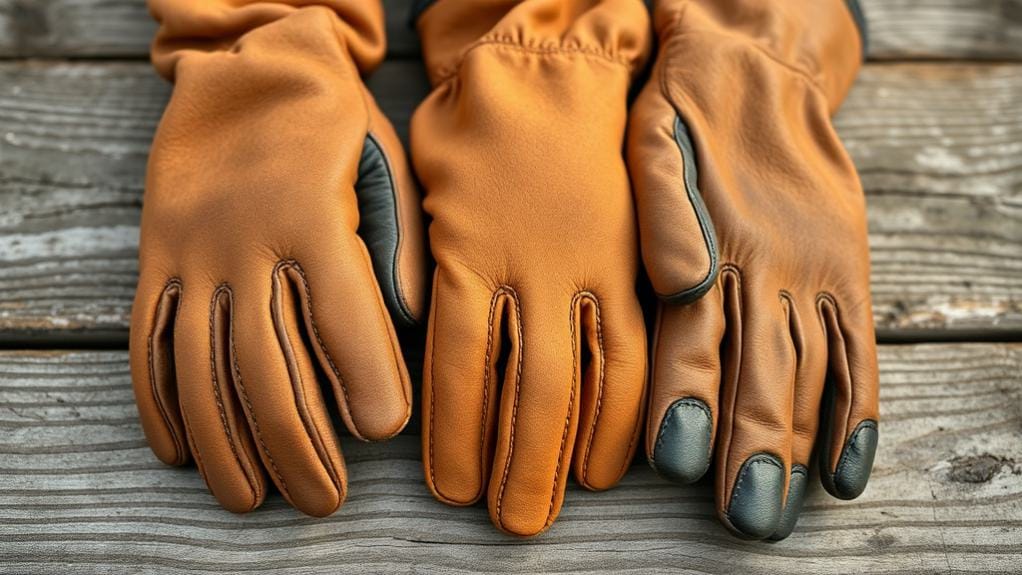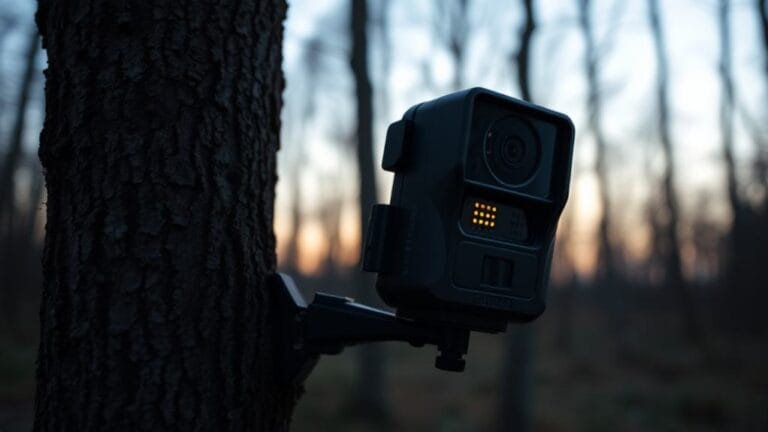When it comes to squirrel handling, we’ve found these three gloves consistently get top marks from wildlife pros:
The Animal Handling Bite Proof Leather Gloves with their 2mm thick construction, the extra-long 23.7-inch Animal Handling Gloves that’ll keep your whole forearm safe, and the reinforced Animal Handling Leather Gloves for maximum bite resistance.
You’ll want double-layered protection and adjustable straps – because trust us, those little tree rats can bite!
Don’t cheap out on thin gardening gloves unless you’re cool with some surprise stitches. Stick around to discover the key features that make these options stand out from the crowd.
Disclaimer: “As an Amazon Associate, we earn from qualifying purchases. Content is AI-assisted and expert-verified. Product recommendations based on testing and research.”
Essential Insights
Table of Contents
- Top-grain leather gloves with double-layered protection and minimum 23-inch length provide optimal safety when handling squirrels.
- Wildlife experts recommend choosing gloves with reinforced palms and fingertips to prevent bites through high-risk contact points.
- Adjustable wrist straps and snug-fitting designs are crucial for maintaining control while handling squirrels without risking escape.
- Cotton-lined gloves with breathable materials prevent hand fatigue and overheating during extended squirrel handling sessions.
- Regular inspection of gloves for tears and proper cleaning after each use ensures continued protection and longevity.
Animal Handling Bite Proof Leather Gloves for Pets and Wildlife
- THICK AND DURABLE: This Animal Handling Gloves Are Made of Thickened Leather, which is More Durable and Strong. And its Cotton Lining Offers...
- EXCELLENT BITE PROOF GLOVES: AOWPFVV Leather Animal Handling Gloves is made by Top Grain Leather and reinforce Double Leather Finger Palms &...
- SUPERIOR SECURITY:The 23.6 inches Animal Handling Gloves has a extra with 13 inches long sleeve protect your Fingers and Forearm from Animal Bite...
- MULTIPURPOSE: This Animal Handling Gloves Can Use for Veterinarians, Animal Control Staff, Groomers, Kennel Workers, Zoo Workers, Pet Shop...
- MULTI - FUNCTION FOR MEN & WOMEN - This Animal Handling Gloves are not only for Handling Pets but also useful for many other work and home tasks....
Professional animal handlers, from veterinarians to wildlife rescue workers, will find these 23.6-inch leather gloves essential for safely managing squirrels and other small animals. You’ll get top-grain leather construction with reinforced double layers on the palms and fingers – because nobody wants a squirrel bite to ruin their day.
These gloves aren’t messing around:
- Extra-long 13-inch sleeve protects your forearms (trust me, you’ll want this)
- Cotton lining keeps your hands comfy while you wrangle those feisty critters
- Thick enough to prevent bites but flexible enough for decent control
Pro Tip: Air these bad boys out before first use. The tanning chemicals smell isn’t exactly a fragrance you’ll want to savor.
They’ll fit most hand sizes, though you might sacrifice some finger dexterity. But let’s be real – would you rather have slightly clumsy fingers or a squirrel latched onto your hand? That’s what I thought.
Best For: Professional animal handlers, veterinarians, wildlife rescue workers, and pet owners who need reliable protection while handling aggressive or unpredictable small animals.
Pros:
- Extra-long 23.6-inch design with 13-inch sleeve provides comprehensive protection up to the elbow
- Double-layered leather construction with reinforced palms and fingers offers superior bite protection
- Versatile enough for multiple uses beyond animal handling, including grilling and gardening
Cons:
- Strong chemical odor requires airing out before first use
- Limited finger dexterity may make precise tasks challenging
- Some users report inconsistent quality and potential defects in construction
Animal Handling Bite Proof Gloves for Pets and Reptiles (23.7 inch)
- Premium material: Made of thickened cowhide, which is more durable and strong. And its cotton lining offers softness, comfort and extra heat...
- Excellent bite proof: Leather Animal Handling Gloves Can avoid bite or scratch from cats, dogs, birds like parrots, squirrels, chinchillas,...
- Size: Total length: 23.7 inch, Palm width: 5.7 inch,14.7 inch Long gloves are possible to protect your arms from potential hurts, the cover...
- Application: Designed for veterinarians, animal control staff, kennel workers, zoo workers, pet shop employees, pet owners, bird handlers,...
- 100% satisfaction guaranteed:Our animal handling gloves will make a great gift for yourself or for an animal lover you know! This Leather Animal...
Versatile animal handlers who need reliable protection against bites and scratches will find these 23.7-inch bite-proof gloves indispensable. You’ll get heavy-duty protection that’s thick enough to handle aggressive cats but flexible enough for precise movements. Think gardening gloves meet kevlar – minus the kevlar part.
These bad boys deliver serious protection for:
- Cranky cats who think your hands are chew toys
- Birds with attitude problems (looking at you, African greys)
- Semi-feral animals who haven’t learned about personal space
- Thorny plant work when you’re taking a break from wildlife
Pro Tip: Don’t get cocky with large dogs – these gloves aren’t magic shields.
The thick material might make you feel a bit clumsy at first but you’ll get used to it. Perfect for claw clipping, bathing, and those fun vet visits where everyone’s favorite pet suddenly transforms into a tiny tornado.
Best For: Animal handlers, veterinary staff, and pet owners who need reliable protection while working with aggressive small animals, cats, birds, and reptiles.
Pros:
- Excellent protection against bites and scratches from smaller animals and birds
- Versatile use across multiple activities including pet handling and gardening
- Durable construction with thick, puncture-resistant material
Cons:
- Not suitable for handling large aggressive dogs
- Thickness may reduce dexterity and fine motor control
- May feel bulky and take time to get used to
Animal Handling Bite Proof Leather Gloves for Pets and Reptiles
- EXCELLENT BITE PROOF: AOWPFVV Leather Animal Handling Gloves is made by Top Grain Leather and reinforce Kevlar Double Leather Finger Palms &...
- SUPERIOR SECURITY FOR FORERAMS - The 23 inches extra long glove with 13 inches long sleeve protect your Fingers and Forearm from Animal bite, Cat...
- THICK AND DURABLE - AOWPFVV Leather Animal Handling Gloves are made from carefully-selected thick and soft shoulder split natural cowhide leather...
- USED By: Veterinarians, Animal Control Staff, Groomers, Kennel Workers, Zoo Workers, Pet Shop Employees, Breeders/Handlers, Pet owners, Bird...
- MULTI - FUNCTION FOR MEN & WOMEN - They are not only for Animal Handling but also useful for many other work and home tasks. Idea for Grill,...
Safety-conscious animal handlers will appreciate AOWPFVV’s protective gloves, which feature superior cowhide leather padding and puncture-resistant design. You’ll get double leather reinforcement on both palms and backs – because nobody wants a squirrel bite for breakfast.
These gloves aren’t messing around. Here’s what you’re getting:
- Professional-grade protection used by actual vets (no kidding)
- Long design that guards your forearms – those little claws can reach
- Sweat-absorbent cotton padding (because wrestling with critters is sweaty work)
Pro Tip: Don’t get cocky – some users report determined biters can still chomp through these bad boys.
They’re versatile enough for other tasks too. Whether you’re handling grumpy cats or wrestling with thorny bushes, these gloves have got your back. Just remember to dry them after use – nobody likes soggy hand protection.
Best For: Professional animal handlers, veterinarians, and pet owners who regularly work with aggressive or untrained animals requiring protection from bites and scratches.
Pros:
- Professional-grade protection with double leather reinforcement on palms and backs
- Versatile use across multiple activities from animal handling to gardening and welding
- Features moisture-wicking cotton padding and machine washable design for practical maintenance
Cons:
- Not completely bite-proof as determined animals can still penetrate the material
- Some users report issues with proper sizing and fit
- May sacrifice some dexterity and grip due to thick protective layers
Factors to Consider When Choosing Protective Gloves for Handling Squirrels

Let’s get real about picking the right gloves before that squirrel decides to make your fingers its next snack. When you’re dealing with these feisty little acrobats, you’ll need to weigh essential factors like material thickness, bite resistance, and how far up your arm the protection extends – because squirrels don’t always aim for your hands. You’ll also want gloves that offer solid grip and finger control without feeling like you’re handling these critters with baseball mitts, so we’re going to break down exactly what separates the actually protective gear from the stuff that’ll have you making an unexpected trip to urgent care.
Material Thickness and Durability
Two critical factors when selecting protective gloves for handling squirrels are material thickness and durability. Let’s face it – those tiny teeth and claws pack a surprisingly nasty punch. You’ll want gloves that can handle the abuse.
Here’s what you need to look for regarding material strength:
- Top-grain leather is your best friend here – it’s like armor for your hands but way more flexible
- Double-layered construction is non-negotiable (because who wants a squirrel tooth reaching their finger?)
- Look for reinforced palm and finger areas – that’s where you’ll need the most protection
Pro Tip: If you can easily bend the material with your fingers, it’s probably too thin for squirrel handling.
The durability factor isn’t just about surviving one encounter. You need gloves that’ll last through multiple sessions. We’re talking about:
- Puncture-proof design (those claws are basically tiny daggers)
- Cotton lining for comfort and moisture control
- Heavy-duty stitching at stress points
Remember: Skimping on glove quality is like bringing a butter knife to a sword fight. Sure, it might work – until it doesn’t. And trust us, you don’t want to find out when it doesn’t.
Length of Forearm Protection
Beyond material strength, proper forearm protection makes the difference between a safe handling experience and a risky one. Let’s be honest – those cute little squirrels can turn into tiny ninjas when they’re scared. That’s why we’re adamant about choosing gloves that extend at least 23 inches up your forearm. Trust us, you don’t want to learn this lesson the hard way.
Here’s what you need to know about forearm protection:
- Don’t even think about using short gloves. Seriously. You need that 23-inch minimum coverage to keep those sharp teeth and claws away from your precious arms.
- Look for gloves with reinforced sleeve extensions. Because a flimsy sleeve is about as useful as a chocolate teapot when dealing with an agitated squirrel.
Pro Tip: Make sure your long gloves still allow enough flexibility to handle the squirrel safely. You’re aiming for protection, not a medieval suit of armor.
The key is finding that sweet spot between length and maneuverability. We’ve seen too many rookies with shorter gloves learn their lesson through battle scars. Don’t be that person.
Grip and Dexterity Control
After ensuring proper length, grip and dexterity control become critical factors in choosing the right protective gloves for squirrel handling. Let’s be real – if you can’t grip that squirrel properly, you might as well be trying to catch soap in the shower. Seriously though, proper grip could mean the difference between a successful handling and a squirrely situation gone wrong.
Here’s what you absolutely need regarding grip and control:
- Textured palm surfaces – because smooth gloves are about as useful as roller skates on ice
- Snug fit without restricting movement – think “second skin” not “oven mitt”
- Balanced protection and flexibility – you need to feel what you’re doing
Pro Tip: If you can’t pick up a pencil while wearing the gloves, they’re too bulky for squirrel handling.
The key is finding that sweet spot between protection and dexterity. We’re looking for gloves that’ll let you:
- Maintain firm control during quick movements
- Perform detailed examinations without fumbling
- Keep a secure hold without stressing the animal
Remember: Dexterity isn’t just about comfort – it’s about safety for both you and our bushy-tailed friends.
Size and Fit Range
Getting the right size and fit out of your protective gloves stands at the top of essential considerations for squirrel handling. Trust us – nothing ruins your day quite like a loose glove that lets a squirrel’s teeth find your finger. You’ll want these babies fitting snug as a bug, but not so tight you feel like your hands are in a straightjacket.
Here’s what you need to nail that perfect fit:
- Look for gloves that extend to your elbow – because squirrels don’t play by “bite zone” rules
- Choose options with adjustable wrist straps for a custom fit
- Make sure you can wiggle your fingers freely (yes, actually try this before buying)
Pro Tip: If you’ve got smaller hands, don’t just settle for “unisex” sizing that feels like wearing oven mitts. Many brands now offer dedicated small sizes.
The right fit means:
- No loose material for squirrels to grab
- Full range of motion in your fingers
- Breathable enough to prevent sweat-fest 2023
- Reinforced fingertips that don’t feel like you’re wearing boxing gloves
Remember: A properly fitted glove is the difference between confident handling and an impromptu squirrel rodeo.
Bite Resistance Level
With your gloves properly fitted, let’s talk about what really matters – keeping those sharp squirrel teeth from reaching your skin. Because trust us, those cute little furballs can pack quite a bite when they’re not in the mood for handling.
You’ll want gloves that offer serious bite resistance, and we’re not talking about your garden-variety yard work gloves here. Look for these essential protection levels:
- Minimum 2mm thick leather or reinforced synthetic material (anything less might as well be tissue paper)
- Double-layered protection at palm and fingertips (where those teeth usually make contact)
- Extended forearm coverage at least 4 inches past your wrist (because squirrels don’t play fair)
Pro Tip: If a glove’s product description doesn’t specifically mention “bite-resistant” or “animal handling,” move along.
The sweet spot is finding gloves that protect without turning your hands into useless mittens. You need enough dexterity to maintain a proper grip – nobody wants a squirrel squirming free because their gloves feel like boxing mitts. Remember: a good bite-resistant glove should feel like armor, not a handicap.
Comfort During Extended Wear
During long squirrel-handling sessions, comfort becomes just as essential as protection. Let’s face it – nobody wants their hands feeling like they’re in a sweaty sauna while trying to handle an energetic ball of fur. That’s why the right comfort features can make or break your squirrel-handling experience.
Here’s what we’re looking for in the comfort department:
- Cotton-lined interiors – Because your hands deserve a cozy sanctuary while you work
- Breathable materials – Trust us, you don’t want to deal with swamp hands
- Snug but flexible fit – Think second skin, not medieval armor
- Elbow-length design – Without feeling like you’re wearing a floppy wizard sleeve
- Sweat-absorbent properties – Because nobody’s winning awards for soggiest gloves
*Pro Tip: Don’t fall for those cheap gloves that feel like wearing plastic bags. Your hands will thank you later.*
Cleaning and Maintenance Needs
Even the most comfortable gloves won’t serve you well if you can’t keep them clean and maintained. Let’s face it – you’re handling squirrels, not organizing your sock drawer. These little critters can carry parasites and diseases, so proper cleaning isn’t optional.
Here’s what you need to know about keeping your gloves in top shape:
- Leather gloves: Spot clean with a damp cloth and mild soap. That’s it. No fancy chemicals or your expensive gloves will end up looking like dried fruit.
- Cotton or synthetic gloves: Toss them in the washing machine. Easy peasy.
Pro Tip: Never dry your gloves with direct heat unless you want them to shrink down to hamster-handling size.
Regular maintenance is essential:
- Check for holes and tears before each use (because a glove with holes is just a really expensive handwarmer)
- Clean after every squirrel encounter – no exceptions
- Let gloves air dry completely before storage
- Avoid harsh chemicals that’ll destroy the material faster than a squirrel destroys your bird feeder
Remember: A clean glove is a safe glove. And trust us – you don’t want to find out what happens when you skip this step.
Frequently Asked Questions
How Long Does It Take to Break in New Squirrel Handling Gloves?
We recommend wearing new squirrel handling gloves for several short sessions over 1-2 weeks to break them in properly. You’ll notice they’ll become more flexible and comfortable as you use them during this period.
Can These Gloves Be Used for Handling Injured or Rabid Squirrels?
We’d use gloves for injured squirrels but never handle rabid ones – that’s strictly for professionals. Call animal control immediately if you spot a rabid squirrel, no matter how protective your gear seems.
What’s the Best Way to Clean and Disinfect Squirrel Handling Gloves?
We recommend washing gloves thoroughly with soap and hot water, then disinfecting with a bleach solution. Let’s air dry them completely and store in a clean place between uses for maximum safety.
Are Children’s Sizes Available for Young Wildlife Volunteers?
Let’s talk tiny hands! We don’t recommend junior-sized protective gear for our young nature enthusiasts. Instead, we’ll help youth volunteers find properly fitting adult small gloves to guarantee their safety while helping wildlife.
Do These Gloves Work Equally Well for Different Squirrel Species?
We’ve found that most protective gloves work well for common squirrel species, but you’ll need thicker gloves for larger species like fox squirrels. Always match the glove’s protection level to the squirrel’s size.
Last Word
We’ve shown you some seriously strong solutions for safely snaring those speedy squirrels. Bottom line: Don’t cheap out on your hand protection – these critters can pack a powerful punch! Whether you’re a wildlife pro or just helping a stranded squirrel, investing in quality gloves isn’t optional. Pick your protection from our proven picks, and you’ll keep your fingers firmly attached where they belong.











